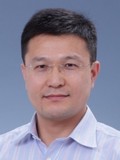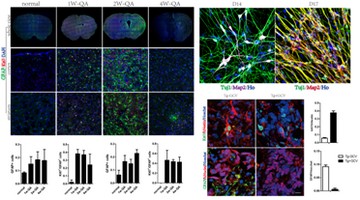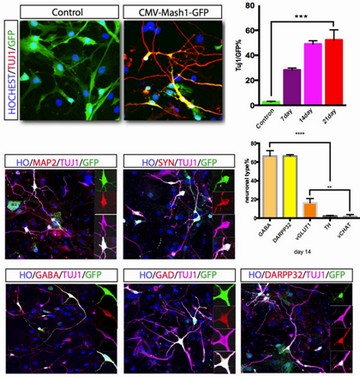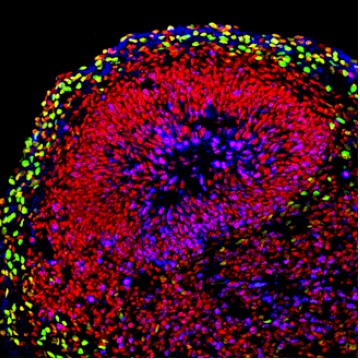 | Baoyang HU, Ph. D. Human stem cells, neural differentiation and regeneration
Co-workers:Dongmei Wang, Mingming Tang, Yun Sun, Da Li, Jing Liu, Can Li, Longkuo Xia, Fan Mo, Jianhuan Qi, Gaoying Sun, Bo Zhan, Haiping Yu, Xuejie Xing, Kailun Liu, Xinyue Wang, Yuanzhi Xie, Chaoqun Wang, Qi Wang, Junli Kan, Zongren Hou,Bonan Liu,Zixia Yu, Tingting Zhang, Yingfei Lu,Ni Wang, Jingyi Zhang,Chang Guo,Huibo Guo, Qiang Wang, Yuanyuan Ji
| | | | | | We are trying to understand mechanisms of human neural differentiation, and dedicate to translating our research into stem cell based therapy and regenerative medicine.
We have devised a chemically defined culture system, with which we can convert human ESCs or iPSCs to regional and functional specific neurons and glia, such as striatal gama-aminobutyric acid (GABA)-ergic neurons, spinal motor neurons and myelin sheath forming oligodendrocytes. Based upon our expertise in neural differentiation of human PSCs, we'll investigate how cell signaling and epigenetic program coordinate the transcription factors to convert human PSCs toward certain type of neurons or glia. An understanding of this knowledge will allow us to develop protocols for scalable production of functional human cells, either through directed differentiation from PSCs or by direct conversion of other types of somatic cells. We'll use mammalian and non-human primate models of the relevant neurological diseases, such as Parkinson disease, Huntington disease and stroke, to investigate how the graft cells integrate into the native circuits of the host brains. Concurrently, using a lately developed protocol of cerebral organoid culture from hPSCs, we are able to discover the unique elements that determine the advanced features of human brain, such as the enlarged cortex and increased gyri. This would allow us to explore in depth the developmental regulation that happens only in human, but not in animal models. 
Reactive astrocytes are temporally heterogeneous and affect the integration of transplanted neural cells.

Overexpression of Mash1 convert astrocytes to projection striatal GABAergic neurons (medium spiny neurons, MSNs).

Cerebral organoids generated from hESCs in 3D culture.(Green: CTIP2, Red: SOX2, Blue: Hoechst).
| Plain English:
Human pluripotent stem cells (PSC), including embryonic stem cells (ESCs) from the earliest embryo and induced pluripotent stem cells (iPSCs) reprogrammed from the somatic cells, hold great promise in regenerative medicine because of their high potential to differentiate into virtually any cell type in the body. We devised a chemically defined culture system, in which the human PSCs were able to differentiate into functionally specialized neurons and glia that hold the native regional identity of the central nervous system. We’ll continue to use this system to dissect the regulatory mechanisms that direct human PSCs differentiating into functional neural cells, and further refine our protocols for scalable production of functional cells. We are also planning to investigate how the graft neurons integrate into the native circuits of the brain, especially under the diseased condition. This knowledge will help us to develop the stem cell based therapeutic strategies for those currently incurable neural degenerative diseases as well as brain and spinal cord injuries. Selected publications: - J. Liu#; Z. Hou#.; J. Wu#; K. Liu; D. Li, T. Gao; W. Liu; B. An; Y. Sun; F. Mo; L. Wang; Y. Wang*; J. Hao*; B. Hu*, Infusion of hESC derived Immunity-and-matrix regulatory cells improves cognitive ability in early-stage AD mice. Cell Prolif 2021, 54 (8), e13085. DOI: 10.1111/cpr.13085.
- J. Wu#; D. Song#; Z. Li#; B. Guo#; Y. Xiao; W. Liu, L. Liang; C. Feng; T. Gao, Y. Chen; Y. Li, Z. Wang, J. Wen, S. Yang, P. Liu, L. Wang, Y. Wang; L. Peng; G. N. Stacey; Z. Hu, G. Feng; W. Li; Y. Huo; R. Jin, N. Shyh-Chang, Q. Zhou, L. Wang; B. Hu*; H. Dai*; J. Hao*, Immunity-and-matrix-regulatory cells derived from human embryonic stem cells safely and effectively treat mouse lung injury and fibrosis. Cell Res 2020, 30 (9), 794-809. DOI: 10.1038/s41422-020-0354-1
- W. Zhu#, B. Zhang#, M. Li#, F. Mo, T. Mi, Y. Wu, Z. Teng, Q. Zhou*, W. Li*, and B. Hu*, Precisely controlling endogenous protein dosage in hPSCs and derivatives to model FOXG1 syndrome. Nat Commun, 2019. 10(1): p. 928. DOI: 10.1038/s41467-019-08841-7
- Y.P. Xu#, Y. Qiu#, B. Zhang#, G. Chen#, Q. Chen, M. Wang, F. Mo, J. Xu, J. Wu, R.R. Zhang, M.L. Cheng, N.N. Zhang, B. Lyu, W.L. Zhu, M.H. Wu, Q. Ye, D. Zhang, J.H. Man, X.F. Li, J. Cui, Z. Xu, B. Hu*, X. Zhou*, and C.F. Qin*, Zika virus infection induces RNAi-mediated antiviral immunity in human neural progenitors and brain organoids. Cell Res, 201 9. 29(4): p. 265-273. DOI: 10.1038/s41422-019-0152-9
- W. Zhu, M. Li, Y. Wu, and B. Hu*, Precise immune tolerance for hPSC derivatives in clinical application. Cell Immunol, 2018. 326: p. 15-23. DOI: 10.1016/j.cellimm.2017.08.005
- W. Zhang#, H. Wan#, G. Feng#, J. Qu#, J. Wang, Y. Jing, R. Ren, Z. Liu, L. Zhang, Z. Chen, S. Wang, Y. Zhao, Z. Wang, Y. Yuan, Q. Zhou, W. Li*, G.H. Liu*, and B. Hu*, SIRT6 deficiency results in developmental retardation in cynomolgus monkeys. Nature, 2018. 560(7720): p. 661-665. DOI: 10.1038/s41586-018-0437-z
- B. Zhang#, Y. He#, Y. Xu#, F. Mo, T. Mi, Q.S. Shen, C. Li, Y. Li, J. Liu, Y. Wu, G. Chen, W. Zhu, C. Qin*, B. Hu*, and G. Zhou*, Differential antiviral immunity to Japanese encephalitis virus in developing cortical organoids. Cell Death Dis, 2018. 9(7): p. 719. DOI: 10.1038/s41419-018-0763-y
- M. Wu, D. Zhang, C. Bi, T. Mi, W. Zhu, L. Xia, Z. Teng, B. Hu*, and Y. Wu*, A Chemical Recipe for Generation of Clinical-Grade Striatal Neurons from hESCs. Stem Cell Reports, 2018. 11(3): p. 635-650. DOI: 10.1016/j.stemcr.2018.08.005
- Y. Wang#, W. Zhu#, M. Wu#, Y. Wu, Z. Liu, L. Liang, C. Sheng, J. Hao, L. Wang, W. Li, Q. Zhou*, B. Hu*, Human Clinical-Grade Parthenogenetic ESC-Derived Dopaminergic Neurons Recover Locomotive Defects of Nonhuman Primate Models of Parkinson's Disease. Stem Cell Reports, 2018. 11(1): p. 171-182. DOI: 10.1016/j.stemcr.2018.05.010
- X. Wang#, T. Li#, T. Cui#, D. Yu#, C. Liu#, L. Jiang, G. Feng, L. Wang, R. Fu, X. Zhang, J. Hao, Y. Wang, L. Wang, Q. Zhou*, W. Li*, B. Hu*, Human embryonic stem cells contribute to embryonic and extraembryonic lineages in mouse embryos upon inhibition of apoptosis. Cell Res, 2018. 28(1): p. 126-129. DOI: 10.1038/cr.2017.138
- Z. Li#, L. Wang#, L. Wang#, G. Feng#, X. Yuan#, C. Liu, K. Xu, Y. Li, H. Wan, Y. Zhang, Y.F. Li, X. Li, W. Li*, Q. Zhou*, B. Hu*, Generation of Bimaternal and Bipaternal Mice from Hypomethylated Haploid ESCs with Imprinting Region Deletions. Cell Stem Cell, 2018. 23(5): p. 665-676 e4. DOI: 10.1016/j.stem.2018.09.004
- L. Yuan#, X. Huang#, Z. Liu#, F. Zhang#, X. Zhu#, J.Y. Yu#, X. Ji, Y.P. Xu, G. Li, C. Li, H.J. Wang, Y. Deng, M. Wu, M. Cheng, Q. Ye, D. Xie, X. Li, X. Wang, W. Shi, B. Hu, P. Shi, Z. Xu*, C. Qin*, A single mutation in the prM protein of Zika virus contributes to fetal microcephaly. Science, 2017. 358(6365): p. 933-936. DOI: 10.1126/science.aam7120
- K. Qian#, H. Huang#, A. Peterson, B. Hu, N.J. Maragakis, G. Ming, H. Chen*, S. Zhang*, Sporadic ALS Astrocytes Induce Neuronal Degeneration In Vivo. Stem Cell Reports, 2017. 8(4): p. 843-855. DOI: 10.1016/j.stemcr.2017.03.003
- T. Li#, G. Feng#, Y. Li#, M. Wang#, J. Mao, J. Wang, X. Li, X. Wang, B. Qu, L. Wang, X. Zhang, H. Wan, T. Cui, C. Wan, L. Liu, X. Zhao, B. Hu, W. Li, and Q. Zhou*, Rat embryonic stem cells produce fertile offspring through tetraploid complementation. Proc Natl Acad Sci U S A, 2017. 114(45): p. 11974-11979. DOI: 10.1073/pnas.1708710114
- Z. Li#, H. Wan#, G. Feng#, L. Wang#, Z. He, Y. Wang, X. Wang, W. Li*, Q. Zhou*, B. Hu*, Birth of fertile bimaternal offspring following intracytoplasmic injection of parthenogenetic haploid embryonic stem cells. Cell Res, 2016. 26(1): p. 135-8. DOI: 10.1038/cr.2015.151
- Y. Jiang#, M. Du#, M. Wu, Y. Zhu, X. Zhao, X. Cao, X. Li, P. Long, W. Li*, B. Hu*, Phosphatidic Acid Improves Reprogramming to Pluripotency by Reducing Apoptosis. Stem Cells Dev, 2016. 25(1): p. 43-54. DOI: 10.1089/scd.2015.0159
- L. Gao, Y. Zhang, B. Hu, J. Liu, P. Kong, S. Lou, Y. Su, T. Yang, H. Li, Y. Liu, C. Zhang, L. Gao, L. Zhu, Q. Wen, P. Wang, X. Chen, J. Zhong, and X. Zhang*, Phase II Multicenter, Randomized, Double-Blind Controlled Study of Efficacy and Safety of Umbilical Cord-Derived Mesenchymal Stromal Cells in the Prophylaxis of Chronic Graft-Versus-Host Disease After HLA-Haploidentical Stem-Cell Transplantation. J Clin Oncol, 2016. 34(24): p. 2843-50. DOI: 10.1200/JCO.2015.65.3642
- H. Chen*, K. Qian, W. Chen, B. Hu, L.W.t. Blackbourn, Z. Du, L. Ma, H. Liu, K.M. Knobel, M. Ayala, and S.C. Zhang*, Human-derived neural progenitors functionally replace astrocytes in adult mice. J Clin Invest, 2015. 125(3): p. 1033-42. DOI: 10.1172/JCI69097
- L. Ma, B. Hu, Y. Liu, S.C. Vermilyea, H. Liu, L. Gao, Y. Sun, X. Zhang, S. Zhang*, Human embryonic stem cell-derived GABA neurons correct locomotion deficits in quinolinic acid-lesioned mice. Cell Stem Cell, 2012. 10(4): p. 455-64. DOI: 10.1016/j.stem.2012.01.021
- B. Hu and S. Zhang, Directed Differentiation of Neural-stem cells and Subtype-Specific Neurons from hESCs, in Cellular Programming and Reprogramming: Methods and Protocols, S. Ding, Editor. 2010, Humana Press: Totowa, NJ. p. 123-137.
- B. Hu, J. Weick, J. Yu, L. Ma, X. Zhang, J. Thomson, and S. Zhang*, Neural differentiation of human induced pluripotent stem cells follows developmental principles but with variable potency. Proc Natl Acad Sci U S A, 2010. 107(9): p. 4335-40. DOI: 10.1073/pnas.0910012107
- B. Hu and S. Zhang*, Differentiation of spinal motor neurons from pluripotent human stem cells. Nat Protoc, 2009. 4(9): p. 1295-304. DOI: 10.1038/nprot.2009.127
- B. Hu, Z. Du, and S. Zhang*, Differentiation of human oligodendrocytes from pluripotent stem cells. Nat Protoc, 2009. 4(11): p. 1614-22. DOI: 10.1038/nprot.2009.186
- B. Hu#, Z. Du#, X. Li, M. Ayala, and S. Zhang*, Human oligodendrocytes from embryonic stem cells: conserved SHH signaling networks and divergent FGF effects. Development, 2009. 136(9): p. 1443-52. DOI: 10.1242/dev.029447
| |

